Population and Community Health Interventions
1/73
There's no tags or description
Looks like no tags are added yet.
Name | Mastery | Learn | Test | Matching | Spaced |
|---|
No study sessions yet.
74 Terms
What do population and community health interventions need to ensure?
Meeting individual, group, and population occupational health needs
What does the occupational therapy practice framework outline occupational therapy's role in?
Health promotion
Triple Aim of Population and Community Health Interventions
1. Improve the health of populations
2. Enhance the care experience (e.g. client-centered)
3. Reduce health care costs
Quadruple Aim of Population and Community Health Interventions
1. Improve the health of the population
2. Improve the patient experience
3. Reduce health care costs
4. Improve care team wellbeing
Quintuple Aim of Population and Community Health Interventions
1. Population health
2. Patient experience
3. Reducing health care costs
4. Care team well-being
5. Equity and inclusion (e.g. needs, data, stakeholders)
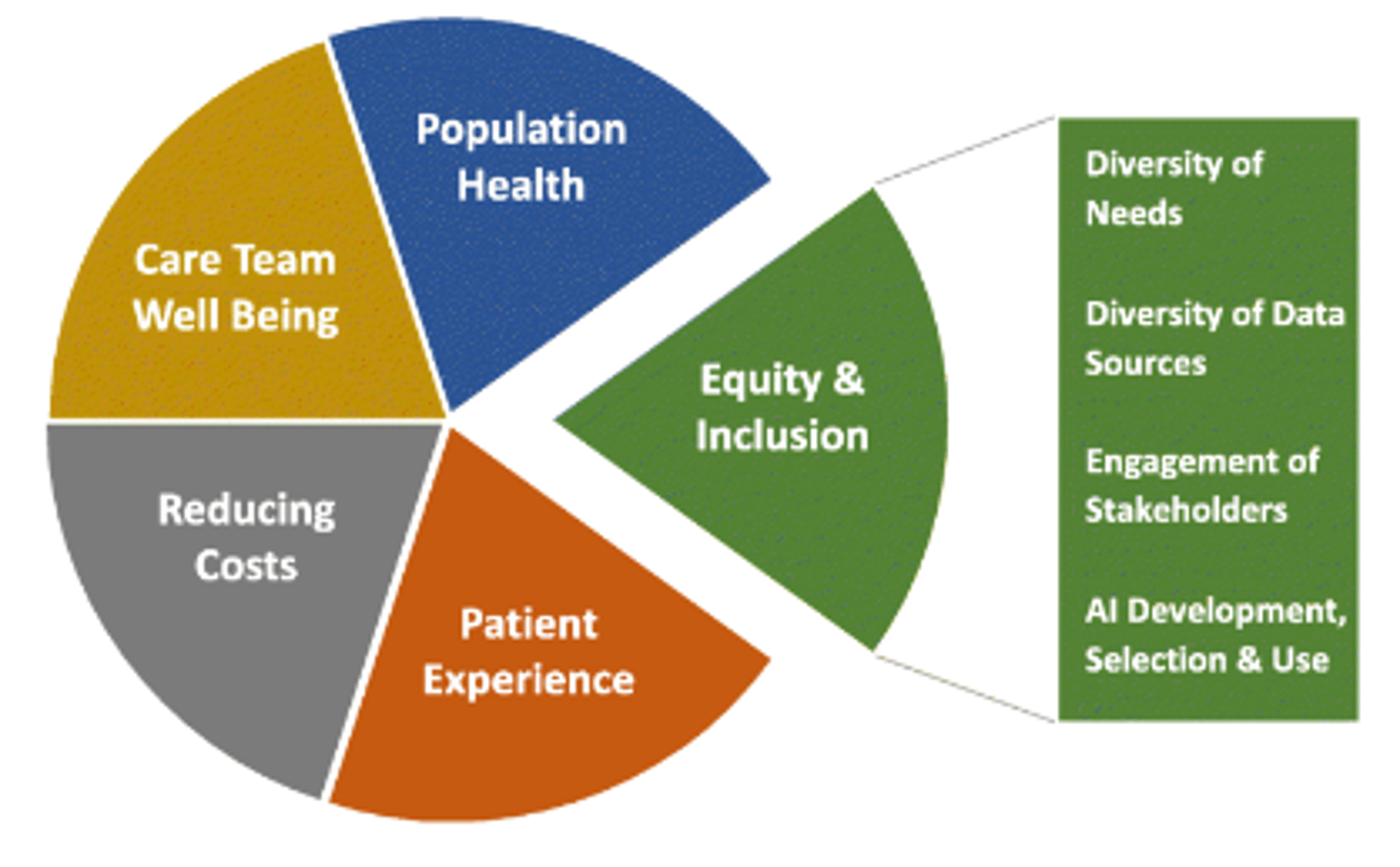
What term can be defined as the levels of cooperation, coordination, and collaboration characterizing the relationships between professions in delivering patient-centered care?
Interprofessional teamwork
Interprofessional Teamwork
Levels of cooperation, coordination, and collaboration characterizing the relationships between professions in delivering patient-centered care
What is a big part of health promotion and education?
Program development
Program Development
Planning and developing implementation and evaluation strategies
What does program development involve?
Continuous cycle of needs assessment, planning intervention, implementation, and evaluation with feedback at each step to revise or improve previous steps
5 Steps of Program Development
1. Needs assessment and analysis
2. Strategic planning
3. Resource mobilization
4. Implementation and monitoring
5. Operational peer review and evaluation
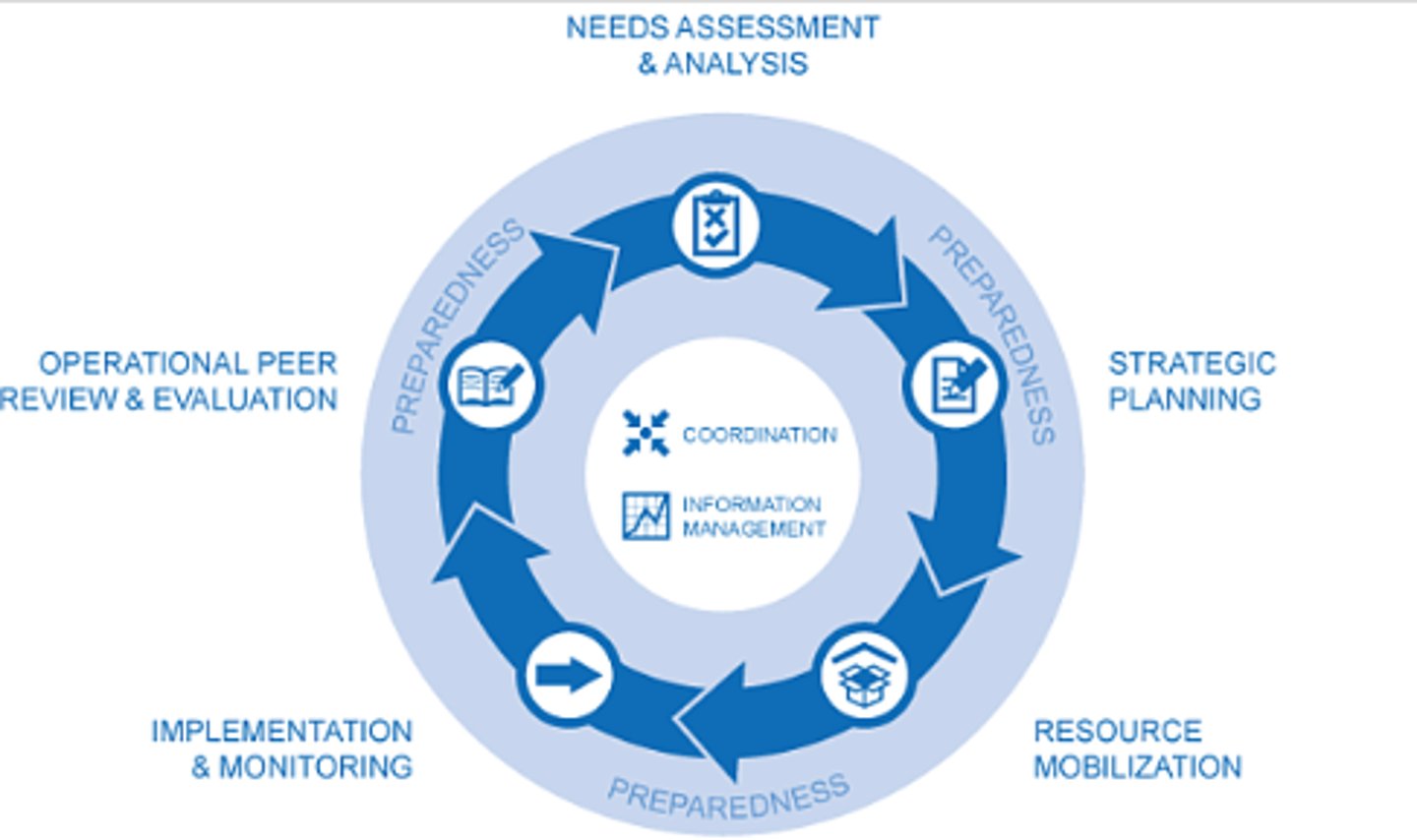
Best Practices of Program Planning
Communication with targeted group
Identifying strengths, weaknesses, opportunities, and threats
Establishing priorities, objectives, and resources
Designing, implementing, and evaluating program activities
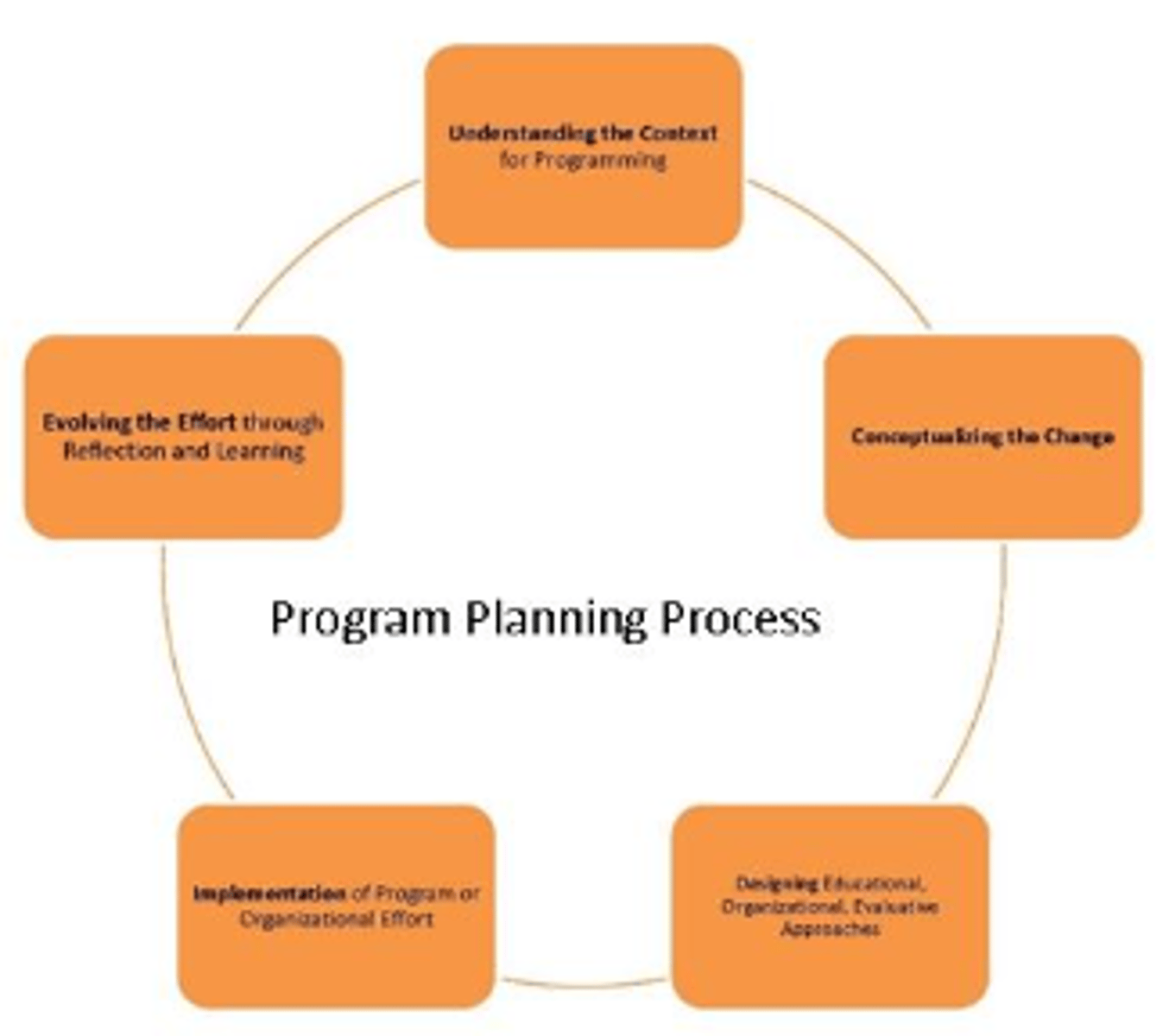
What is the most important step before initiating a program?
Preplanning
Preplanning of Program Development
Who should be involved (e.g. key stakeholders)?
When should planning occur?
What resources are needed (e.g. internal, external)?
What process will be followed (e.g. brainstorming)?
Stakeholders
Persons who may or may not benefit directly being involved in the potential program but who may have a stake in the program's outcome and often the ability to influence that outcome
What stakeholders should those developing a program start with?
The people they wish to serve within the community
What is key in program development?
Collaboration (shared decisions)
Cooperation (working together)
Coalition (team)
What data can program developers use to gather information in the preplanning phase?
Previous data from other sources
Qualitative data (e.g. focus groups, interviews, testimonials)
Internal and External Resources of Program Development
Attitudes
Policies
Available expertise
Time
Space
Money
Priorities that fit with an organizations mission
What term can be defined as a collaborative approach to research that equitably involves all partners in the research process and recognizes the unique strengths that each brings?
Community based participatory research
Community Based Participatory Research
A collaborative approach to research that equitably involves all partners in the research process and recognizes the unique strengths that each brings
What is the difference between program development and community based participatory research?
Mutual ownership and shared decision making
Building partnerships between researchers and communities
Range of settings (e.g. rural vs urban)
Variety of research methods
What does community based participatory research start with?
A research topic of importance to the community
What is the aim of community based participatory research?
Combine knowledge with action to achieve social change, improve health outcomes, and eliminate health disparities
Purpose of Community Based Participatory Research
Open communication with community members
More likely to meet community needs
Community's attitudes can change benefitting the community
Breaks down cultural, racial, and class barriers
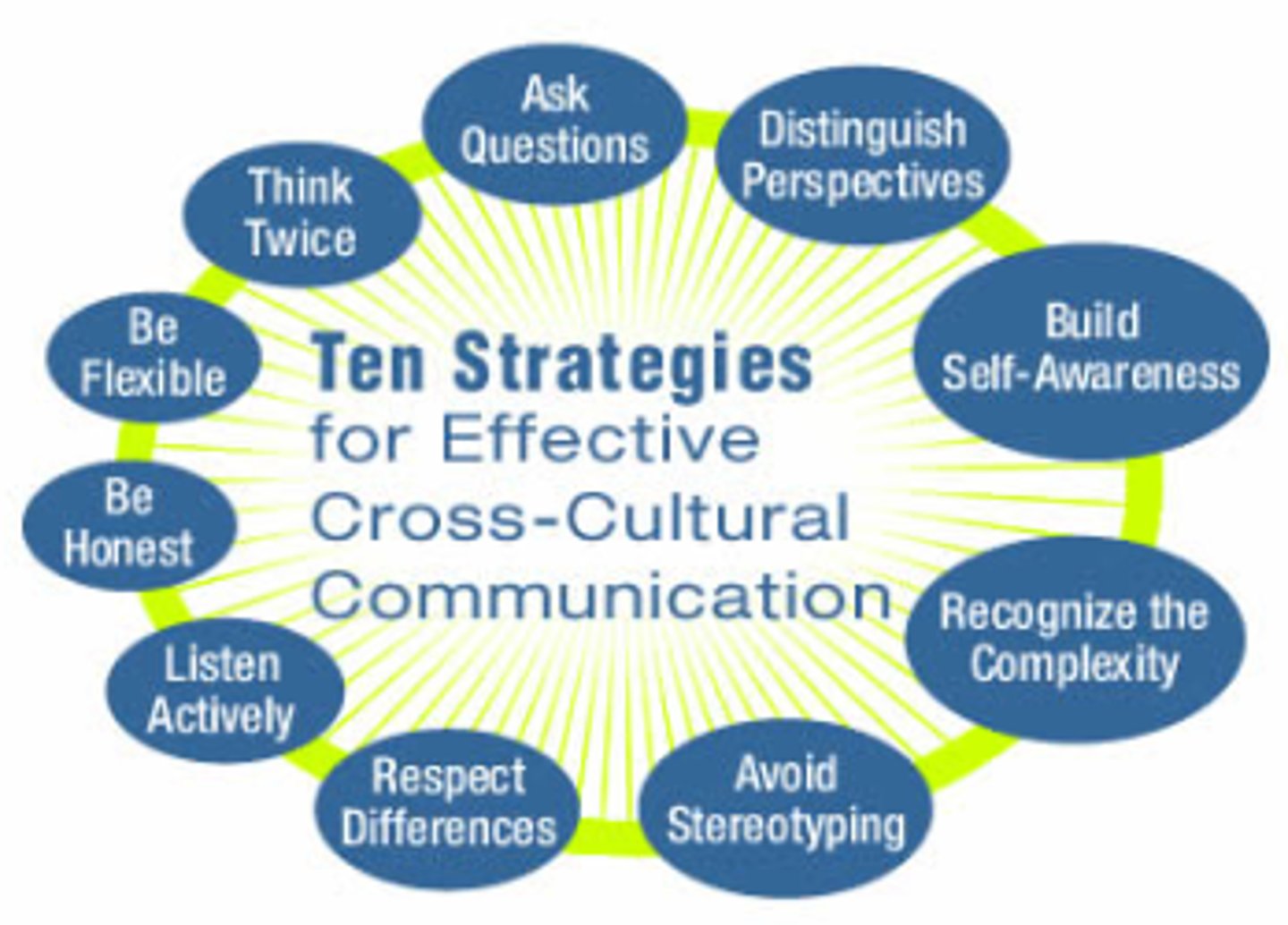
Community Based Participatory Research Process
Community assessment and diagnosis
Defining the issue and forming a research question
Implement
Evaluation and interpreting results
Disseminating and translating research findings
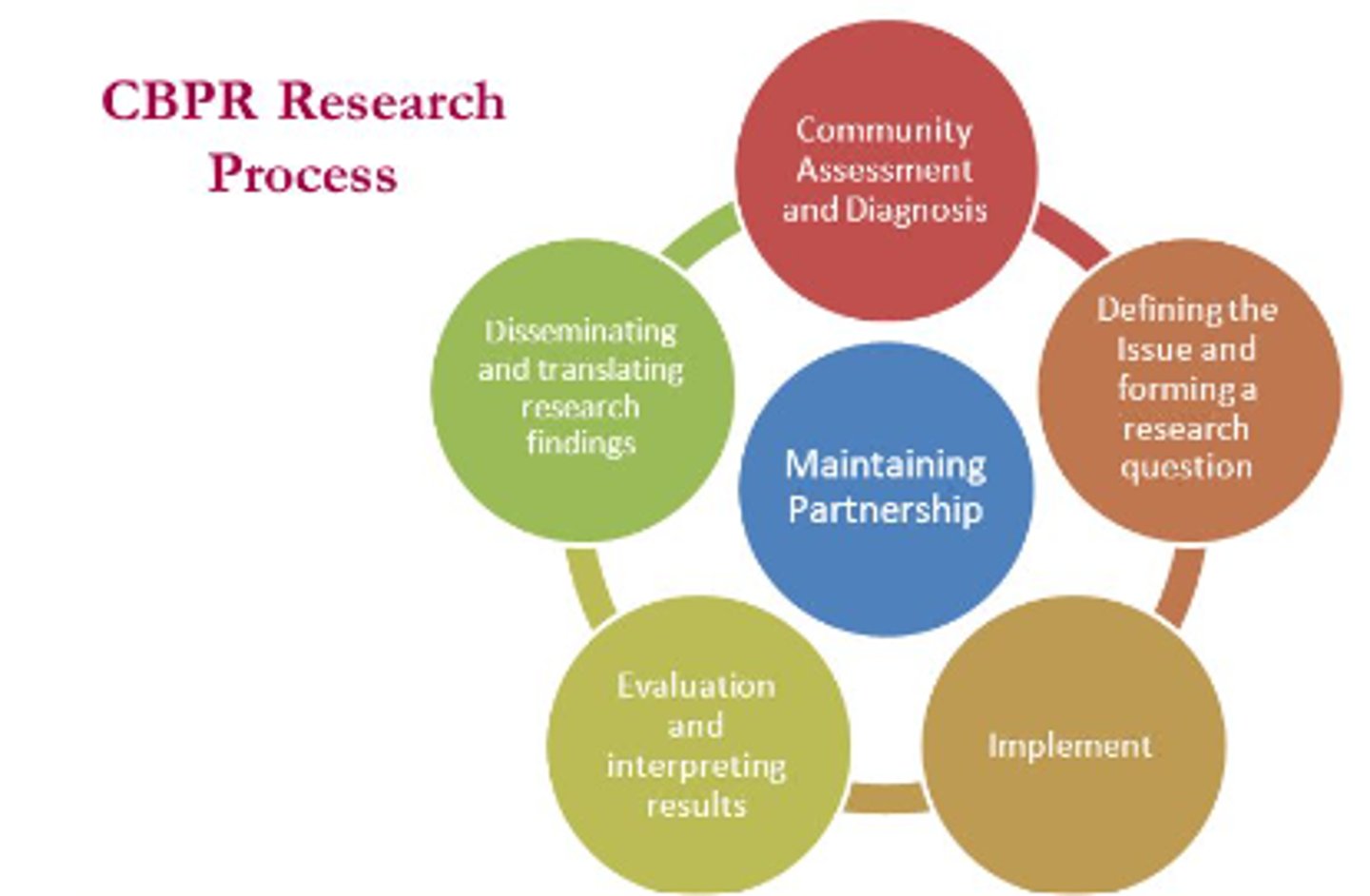
How does community based participatory research involve communities?
Community entry
Health problem identification
Study design (e.g. pre/post-test)
Participants recruitment and retention
Data collection
Data analysis and reporting
Report dissemination (e.g. conference)
Who is involved in community based participatory research?
People most affected by the research issue
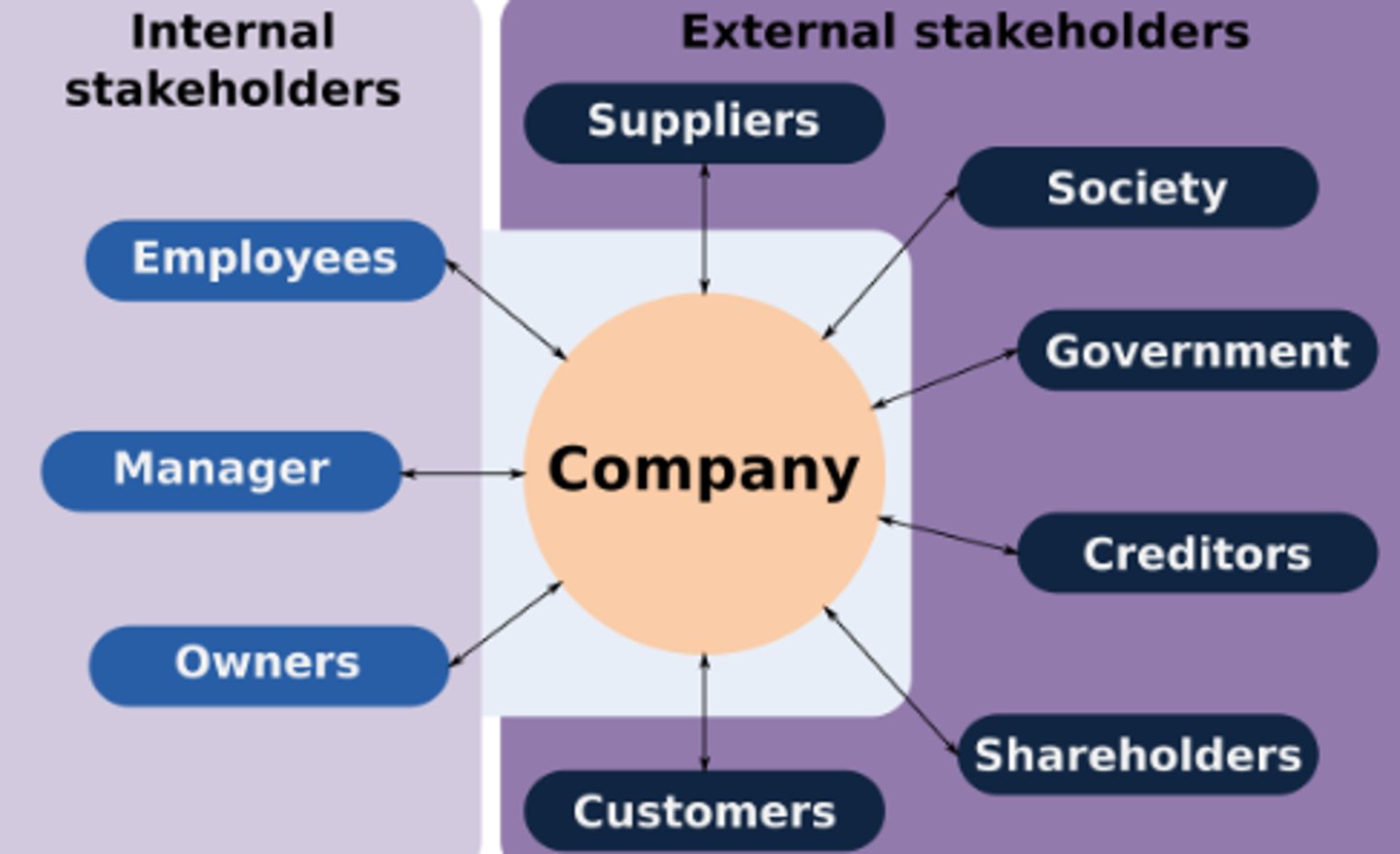
Who is trained in community based participatory research?
Both academics and lay community members
Who does community based participatory research assist?
Target community
What data is collected in community based participatory research?
Qualitative research
Quantitative research
3 Models of Community Based Participatory Research
1. Single-theme collaboration
2. Targeted, area-based collaboration
3. Broad-based coalition
Who does single-theme collaboration most commonly occur between in community based participatory research?
A university-based center and a community organization
Who does targeted, area-based collaboration most commonly occur between in community based participatory research?
Academic researchers and a small group of community organizations
Who does the broad-based coalition most commonly involve in community based participatory research?
Grassroots organizations
3 Types of Community Based Participatory Research Interventions in Occupational Therapy
1. Community-based
2. Community-level
3. Community-centered
Which type of intervention provides health services in community settings where people live, work, go to school, or play (e.g. community mental health); community-based, community-level, or community centered?
Community-based
Which type of intervention is population focused, changing norms in behavior to facilitate health outcomes (e.g. smoking cessation at restaurants, drinking and driving, sexually transmitted infections prevention); community-based, community-level, or community centered?
Community-level
4 Types of Community-Level Interventions
1. Sociocultural
2. Economic
3. Political
4. Environmental
What are community-level interventions based on?
Loose partnerships and grant funds
Which type of intervention is initiated by the community (e.g. food/meal services post hurricane Harvey organized by the community with assistance from researchers and corporations); community-based, community-level, or community centered?
Community-centered
What do community members act as in community-centered interventions?
Experts (seeking additional support if needed)
What do researchers act as in community-centered interventions?
Resources or facilitators
3 Models of Community Based Participatory Research in Occupational Therapy
1. MAPIT (mobilize, assess, plan, implement, track)
2. Person-Environment-Occupation-Performance Model
3. Quality of Life Model (doing, being, belonging, becoming)
What type of analysis can a clinician conduct using the Person-Environment-Occupation-Performance Model in community based participatory research?
Situational analysis (e.g. population description, environmental scan, health status, intrinsic factors, occupational participation)
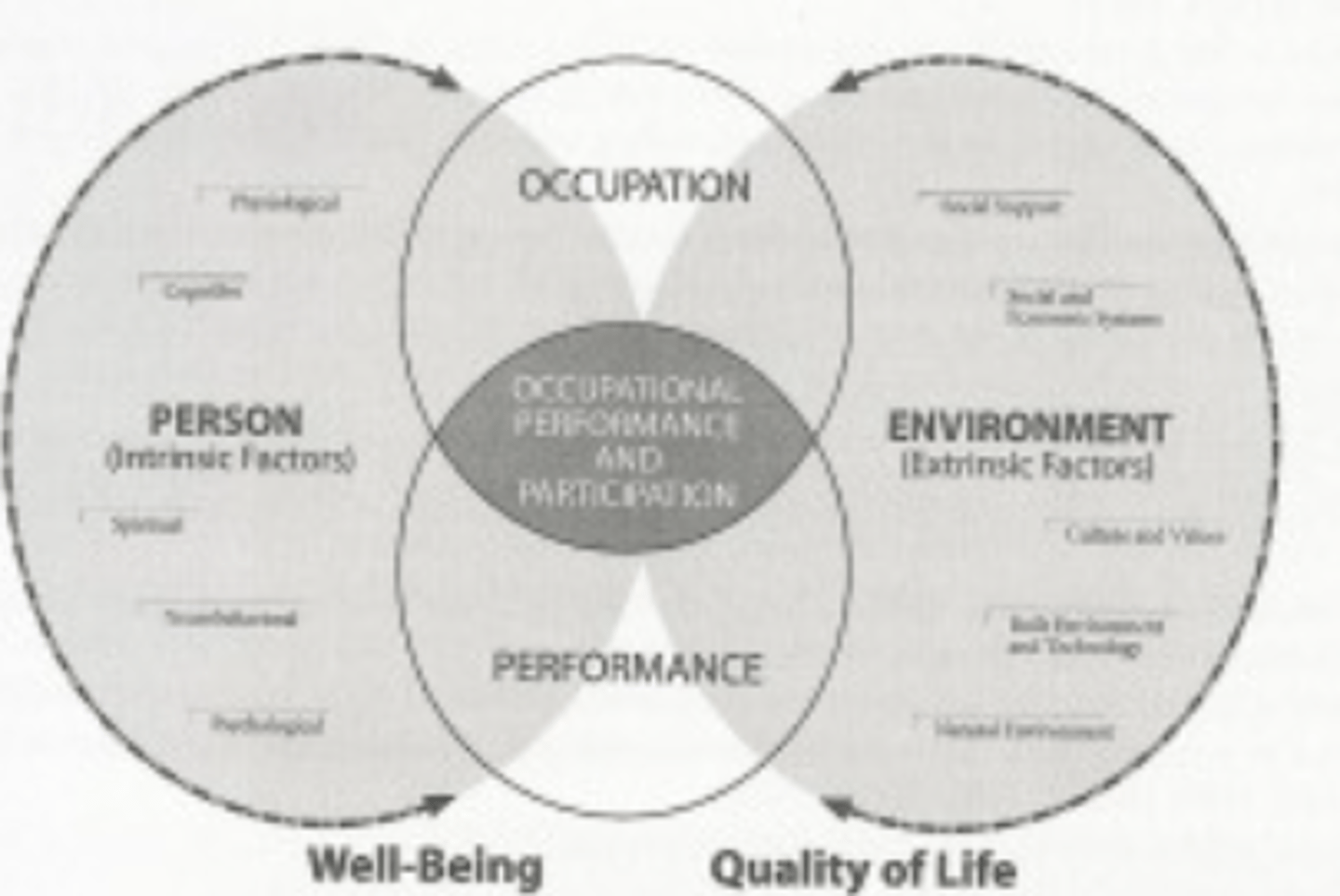
Purpose of Occupational Therapy in Community Based Participatory Research
Capacity building (e.g. synergy - working together)
Developing a shared vision
Sustainability
What term can be defined as the process of identifying strengths, assets, needs, and challenges specific to a targeted community or population?
Needs assessment
Needs Assessment
Process of identifying strengths, assets, needs, and challenges specific to a targeted community or population
Tools of a Needs Assessment
Data analysis
Interviews and observations
Focus groups
Personas (e.g. archetype)
Case
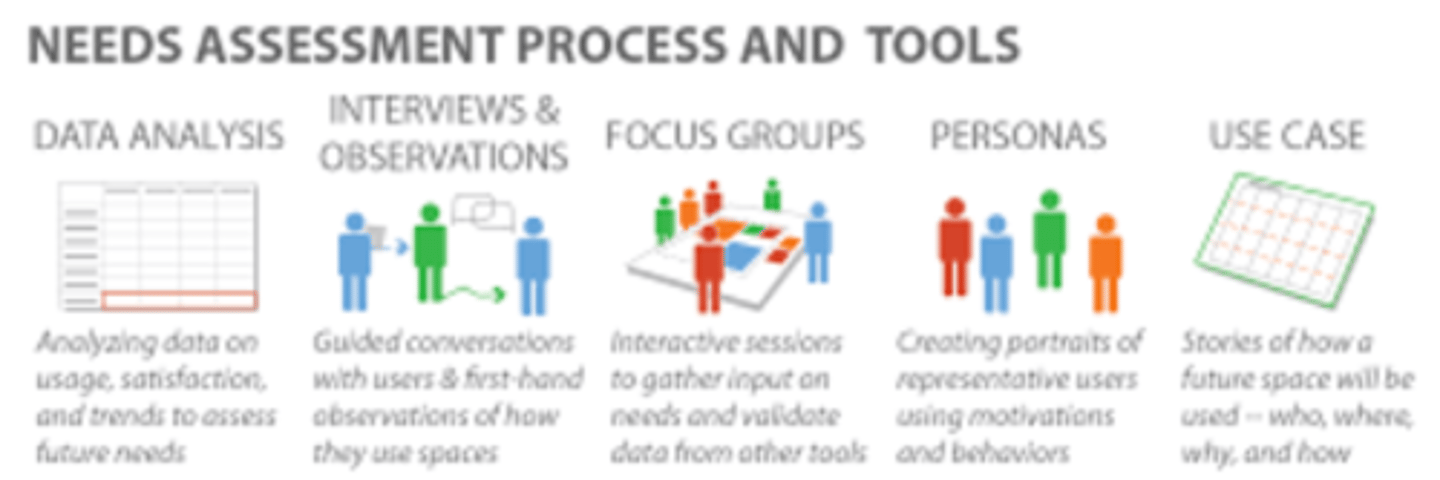
2 Phases of a Needs Assessment
1. Planning and organizing
2. Methodology
What occurs during the planning and organizing phase of a needs assessment?
Information gathering (e.g. identify needs of target population)
Learn about community being assessed (e.g culture, resources)
Determine area of needs assessment
Perform a literature review
Identify goals and objectives (e.g. strategy, roles, schedule)
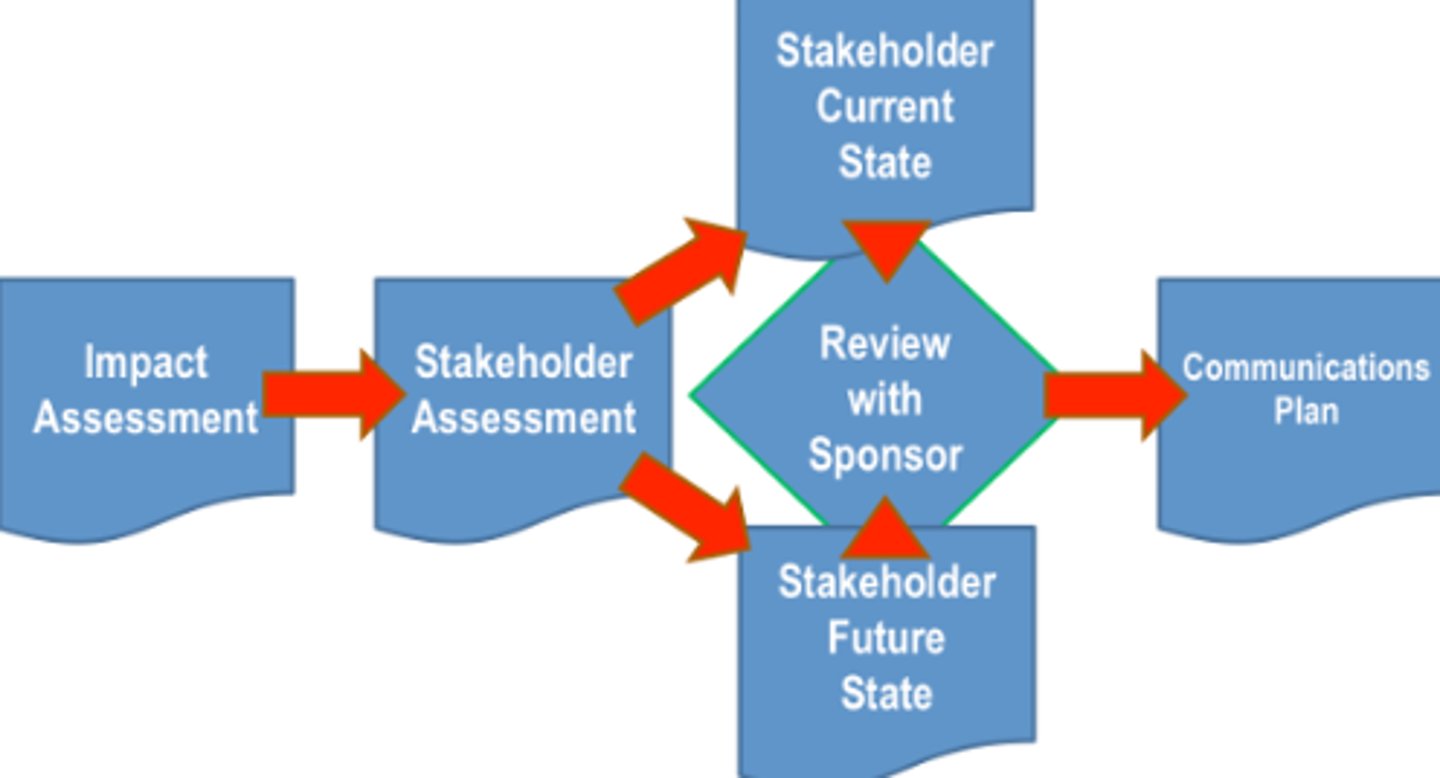
Who is information gathering in the planning and organizing phase of a needs assessment facilitated by?
Care provider
Practitioner
Community leaders
Community as a whole
What occurs during the methodology phase of a needs assessment?
Preparation (e.g. outcome measures)
Community profile (e.g. population, condition, context)
Evaluation (e.g. effectiveness, efficacy, achievement, results)
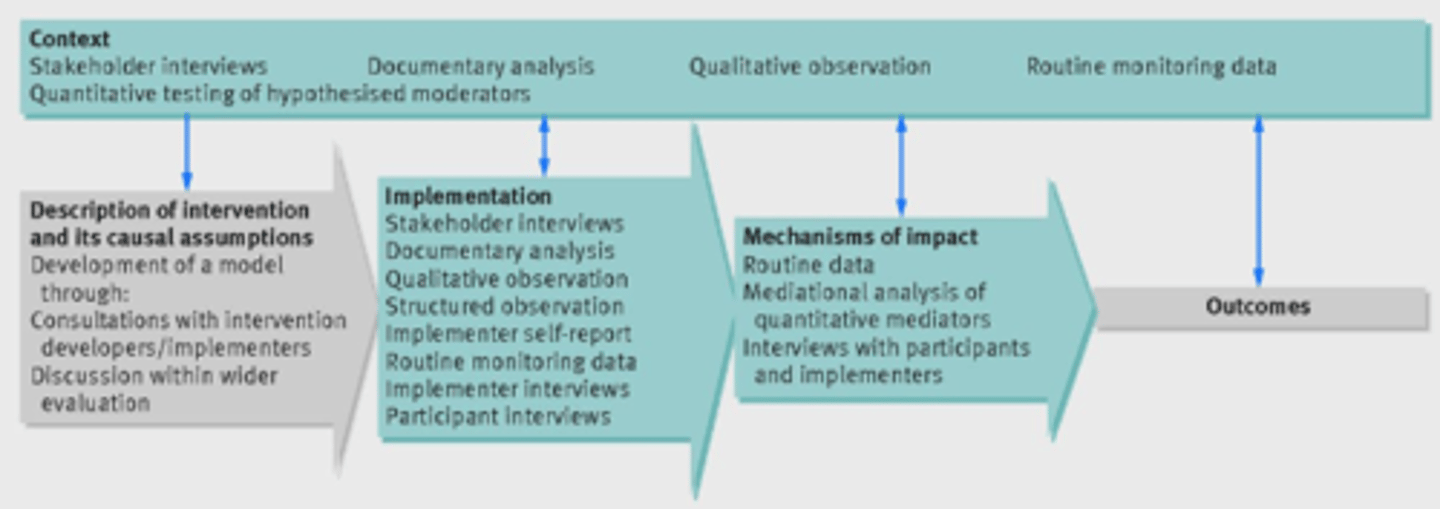
Outcome Measures of a Needs Assessment
Focus groups
Surveys
Town halls
Data collection
Data analysis
Final report presentation
Data Collection of a Needs Assessment
Secondary data (e.g. stakeholders, funding, time)
Written questionnaires
Interviews
Public forums (e.g. townhalls)
Focus groups
What term can be defined as the ideal state or ultimate level of achievement to which the organization aspires; vision or mission?
Vision
Vision
The ideal state or ultimate level of achievement to which the organization aspires
What term can be defined as an organization’s core purpose or the basis for its existence, focus, and actions; vision or mission?
Mission
Mission
An organization's core purpose or the basis for its existence, focus, and actions
INSPIRE Model
Identify core values
Name the population
Set the vision
Plan how to achieve the mission
Identify activities that align with the mission
Review, revise, and refine
Enlist others
Community Program Implementation Plan
Target population (e.g. who will the program serve?)
Recruitment (e.g. how will the program recruit those in need?)
What should the practitioner do prior to writing goals?
The practitioner should link the programming, implementation, and evaluation plan
Difference Between Goals, Objectives, and Activity
Goal: What is the aim
Objective: Attached to goals to ensure the desired result
Activity: Tasks performed that are aligned with goal/objective
SMART Objectives
Specific
Measurable
Attainable
Realistic
Time

What type of interventions offers health services in a community setting in which people live, work, go to school, or play?
Community health
Community Health
Offers health services in a community setting in which people live, work, go to school, and play (e.g. St. Vincent's)
3 Types of Community Partnerships
1. Community action (e.g. specific community issue or problem)
2. Community organization (e.g. agencies share same purpose)
3. Community development (e.g. increased participation of all)
How is trust established in the community?
Costs and benefits analysis
4 R's of Trust
Cultural norms
4 R's of Trust Establishment in the Community
1. Reliability
2. Roles
3. Respect
4. Rituals
2 Parts of a Sustainability Plan
1. Identify challenges to sustainability
2. Consult a committee or task force
Community Health Programs
Better Living for Texans
Healthy Texas women
STREETS (Safe Travel Environment Evaluation in Texas Schools)
Better Living for Texans
A statewide nutrition education program for adults and kids who want to learn how to eat well and save money
Healthy Texas Women
A program dedicated to offering women’s health and family planning at no cost to eligible women in Texas (e.g. help women plan their families)
STREETS (Safe Travel Environment Evaluation in Texas Schools)
Study will be conducted over a five-year period, and will ultimately help schools identify the most successful and efficient methods to promote active commuting like walking and cycling